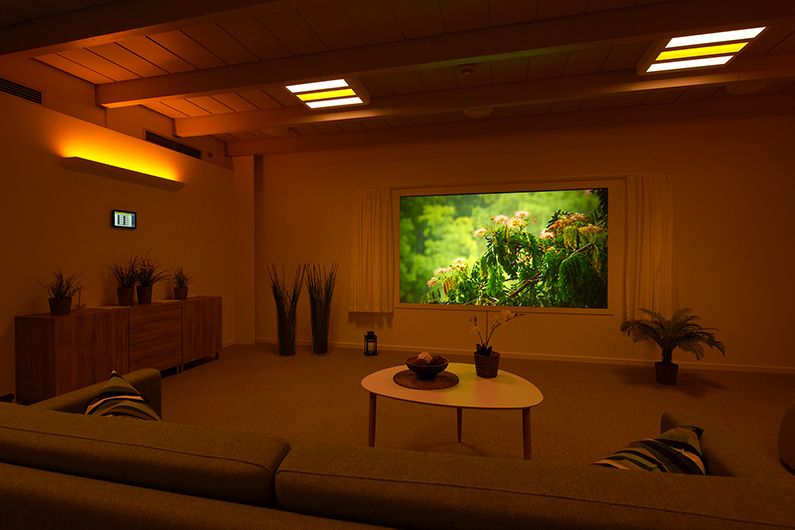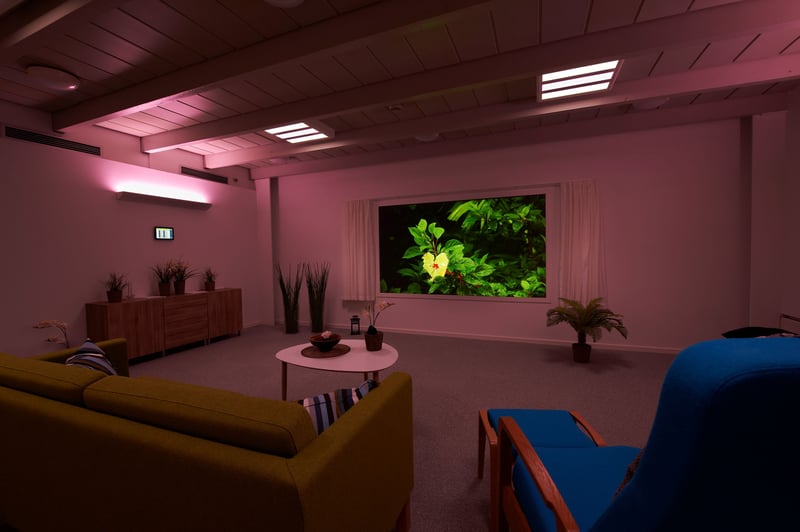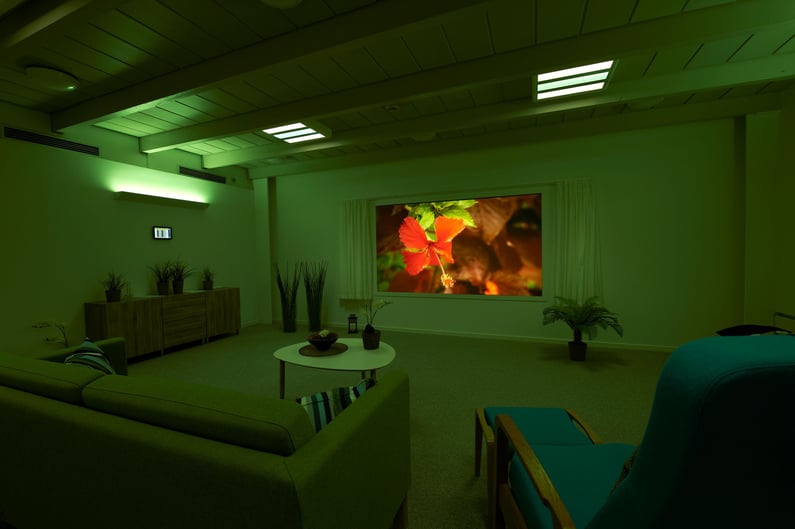DemensCentrum Aarhus is actively working with stimuli in a new combination of light, sound, and images to calm agitated dementia patients. The results of the analysis show that the tailored stimuli help the dementia patient to relax, reduce wandering, and increase presence and happiness.
People with dementia often experience restlessness and can exhibit outwardly agitated behaviour. They may also struggle with disrupted sleep patterns. These challenges can be difficult to manage for individuals with dementia, as well as the caregivers and family members involved.
When staff members are searching for a solution, medication is often the answer, but it can create new problems due to a range of side effects.
På DemensCentrum i Aarhus Kommune har man derfor det sidste år arbejdet målrettet med stimuli som en ikke-medicinsk løsning, for at reducere brugen af medicin og samtidig opnå en effekt i forhold til de demensrelaterede udfordringer. I 2015 etablerede centret en stimulistue, hvor lys, lyd og billeder er skræddersyet til demensramte. Det har givet et non-farmakologisk redskab, som kan afprøves før man anvender medicin.
Practical evidence through systematic measurements
The staff immediately noticed a positive impact on the residents with the introduction of the new lounge, and they have been systematically recording the usage and effects of the lounge over a six-month period. This has resulted in multiple registrations from 46 individuals with dementia.
— We wanted to document the effect we were experiencing in our daily lives. That's why we conducted the analysis, and the results speak for themselves. The sensory room has a clear impact. For example, on those with dementia who are angry and restless, both physically and mentally. With the sensory room, they can find a place where they can calm down and feel good. And for some, that can be very difficult otherwise, explains Jeanette Jepsen, an occupational therapist and project manager for the sensory room.

— We also have many residents who experience mental restlessness, constantly wandering around and perhaps shouting or leaving. This can be very disruptive, not only for the other residents but also for the staff. Now, we can offer them the sensory room, and after spending some time there with them, we can often leave them to sit on their own. This is a significant relief in terms of resources, says Jeanette Jepsen.
Furthermore, Jepsen highlights the positive effects on mood and energy, which can reach up to 100%. In situations where a resident is feeling down, the staff now has a great opportunity to alleviate their distress.
Additional positive outcomes
In addition to the documented effects of the sensory room, the staff has also observed a number of significant secondary effects. The report highlights that the room can support the challenging process of moving in, tapering off medication, and enhancing positive experiences with family members.
— One resident we had was unable to recognize his own family, neither in the hallway nor in his own room. However, when he entered the sensory room and spent some time there, he was able to recognize his family, his son again, says Jeanette Jepsen.
Sound, light, and visuals
The sensory room is a cozy and comforting space where the combination of sound, light, and visuals provide stimulation for individuals with dementia in challenging situations.
On the wall in the room hangs a 110'' screen with built-in speakers, creating a unified audiovisual experience that helps individuals with dementia stay focused. The music, carefully curated by a music therapist, plays in sync with the visuals displayed on the screen. To enhance the ambience, curtains are placed around the screen, giving the impression of sitting and looking out of a window. The screen showcases various films and images, such as a school bus ride or serene still images that evoke a sense of calmness and evoke memories.

The room is equipped with Chromaviso Circadian Lighting, which includes both circadian lighting and various coloured light settings that support the mood, therapy, and activities taking place in the room. For example, a blue light is used for regulating circadian rhythm, a white light is used for activities and energy, and a soothing pink light is used to help the resident relax and unwind.
— Many individuals with dementia experience disturbed sleep patterns and wander around at night. Now, we bring them into the sensory room and gradually adjust the lighting to help them calm down, such as by using a night light or simulating a sunset. We had one resident who even slept in the room at night for a period of time until her sleep pattern was restored, says Jeanette Jepsen.
The lighting solution was developed by Chromaviso, a company based in Aarhus, drawing on their experience in somatic and psychiatric hospitals as well as other care centres.
— The sound, visuals, and lighting in the sensory room have been specifically designed to address the everyday challenges faced by individuals with dementia. Lighting plays a crucial role in regulating sleep patterns, creating a soothing atmosphere, and setting the mood. At DemensCentrum, the coloured lighting settings are used effectively to help residents establish a rhythm, find calmness, and experience a sense of presence. The flexibility of the lighting is essential in creating a space that can be used for various purposes, including therapy, relaxation, awakening, socializing, and other activities, explains Anders Kryger, CEO at Chromaviso.
Researcher: Great potential in the approach
Rikke Gregersen, a researcher in ageing and dementia from VIA University College, has closely followed the project and visited DemensCentrum Aarhus as part of their shared research interests in therapeutic sensory stimulation (known as snoezelen) and psycho-social interventions.
— Currently, there is no medication for dementia. The best treatment today is non-pharmacological. And in this regard, we know that crucial factors for promoting well-being in individuals with dementia, such as managing agitated or restless behaviour, depend on the skills of the staff and the environment they are in, says Rikke Gregersen, continuing her statement.
— Individuals who struggle to process sensory stimuli, and easily become confused, agitated, or apathetic can benefit from sensory stimulation that provides pleasant auditory, visual, and tactile experiences. We have a concept here that has a very positive effect on many individuals and also offers small pockets of recreation where people with dementia can relax. Moreover, the entire concept is based on existing knowledge about the impact of colours and light on mood and regulated wakefulness and circadian rhythms, stimulation through soothing music, and images and short film sequences specifically designed for individuals with dementia that can evoke memories. It's a comprehensive approach that takes all these elements into consideration.
One of the aspects highlighted by Rikke Gregersen in relation to the work with the specific sensory room at Demens Centrum Aarhus is its design to encourage frequent use.
—At Demens Centrum Aarhus, they have placed a high priority on their work with the sensory room, taking a very professional approach. Both staff and relatives have actively participated in using the room with the residents, creating a sense of closeness and connection. The relatives themselves are able to experience a deep presence and connection with their loved ones in the sensory room, and it is positive that they are allowed to operate the room themselves, she explains.

A collaboration between the business world and the local municipality
The project came about through a collaboration between research, the municipality, and private companies, facilitated by MTIC, which supports innovation in MedTech and brought Solutors, Visiosign, and Chromaviso together.
— We have been working on health-promoting lighting for hospitals and psychiatry for the past 10 years. A project like this, where we work closely with users, municipalities, and researchers, provides us with valuable knowledge and opens doors in new segments, such as care, where there is a great need for new welfare technological products to address everyday challenges, concludes Anders Kryger from Chromaviso.
FACT SHEET
The Sensory Room
The sensory room is designed to provide a cozy and inviting space for individuals with severe dementia and their specific needs. The room incorporates sound, light, and visuals, all of which are carefully coordinated and controlled through a centralized touchscreen. To create a serene atmosphere, any distracting elements such as wires and technology are discreetly hidden away.
- Visuals: On the wall, a captivating 110'' screen hangs, displaying films and images that evoke positive memories and create unforgettable experiences.
- Sound: The music is curated by a music therapist, taking into consideration rhythm, and repetition, and incorporating sounds from animals and nature.
- Light: The lighting system includes various coloured settings that can be selected depending on whether the purpose is energy, muscle relaxation, or calming. When a resident has spent time in the sensory room with relaxing lighting, a special lighting program is used to awaken them, gradually increasing in brightness and colour over a period of 7 minutes. The program begins with a golden sunrise and ends with bright white light. This transition is experienced as natural and calming by both the residents and staff.
Practical Evidence
Based on extensive observations across 46 residents, the following effects have been documented:
- 100% of the 10 residents with low moods experienced a positive impact from their time in the sensory room.
- 93% of the 14 residents who were very passive reported feeling more alert and active after stimulation, with temporary relief from sadness.
- There was an 86% success rate in managing anger and outwardly aggressive behaviour among 12 out of 14 residents.
- The sensory room had a positive effect on 83% of the 30 residents experiencing physical and psychological restlessness, including wandering and shouting.
- 75% of the 4 residents who sought to exit the premises experienced positive effects.
- 63% of the 8 residents with sleep problems and disrupted circadian rhythms found solace and were able to fall asleep in the sensory room.
Additional benefits
Moving In: Often, the move to a nursing home can be an unsettling and stressful experience for a new resident. And for their loved ones and staff as well. It involves new surroundings, unfamiliar faces, and different sounds. This is where sensory stimulation has been hugely successful in calming and supporting the process.
Loved Ones: For many family members, the sensory room has been a positive experience. It enhances their ability to be present and recognize their loved ones.
Nutrition: In the sensory room, residents are better able to find peace and collaborate in eating and drinking. A combination of soothing lighting and focused attention promotes a conducive environment.
Overordnede konklusioner
- The sensory stimulation has a significant impact on restless and outwardly aggressive individuals, reaching up to 83-86%. However, the most targeted effect is seen in passive individuals, where the impact reaches as high as 93-100%.
- Furthermore, sensory stimulation has a positive effect on sleep problems, and further studies and a more targeted approach are expected to support the use of sensory stimulation in reducing medication.
- Moreover, sensory stimulation contributes to qualitative considerations such as a smoother and calmer transition for new residents and an improved experience and communication for their loved ones. Additionally, it also helps promote a sense of peace and collaboration when it comes to food and drink consumption.

